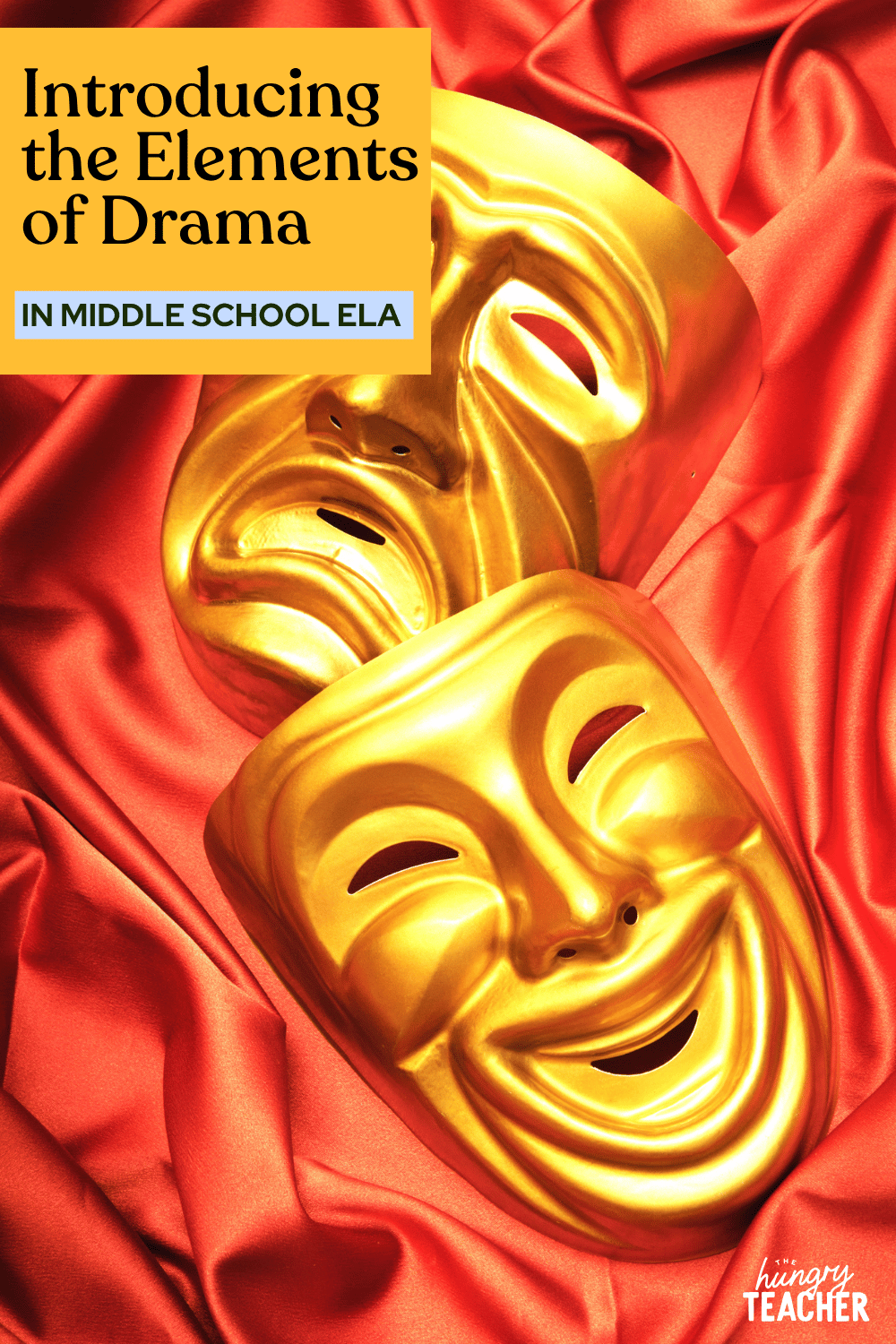hey friend!
I'm Martina.
I provide practical, time-saving strategies that actually work—so you can engage your students, teach effectively, and reclaim your time from the exhausting planning-grading cycle.
Browse Our ELA Resources
Introducing the Elements of Drama in Middle School
My first year teaching middle school, I dove head first into my drama unit. But I quickly realized that even though students are identifying the same literary skills – conflict, climax, theme – dramas have many stand-out features that students need to understand first. Which is why I recommend starting with the elements of drama and drama terms. Because if your students don’t know what a flashback is or what stage directions are, it’s going to be hard to analyze the text.

Elements of Drama
Let’s start with the elements of drama. These are the “characteristics” that set drama apart from other genres. Of course, dramas also have characters, conflict, plot, theme, and more. But these elements give drama that something special.
- Prologue – A separate introduction of a literary or musical work.
- Epilogue – A section at the end of a book that serves as a comment on or a conclusion to what has happened.
- Fourth Wall – The conceptual barrier between a fictional work and its viewers or readers. When plays, television shows, and movies break the fourth wall, they acknowledge the audience and speak directly to them.
- Flashback – Move to a scene in a movie or novel that is set in an earlier time than the main story.
- Flash Forward – Move to a scene in a movie or novel that is set in a time later than the main story.
- Full Circle – The outcome of a complex situation or the sequence of events in a literary work where the aftermath of the story is addressed, everything comes full circle, and a sense of closure is reached.
- Denouement – The final part of a play or movie where things are made clear and matters are resolved.
I like to introduce the elements of drama with an interactive notebook lesson. This gives me a chance to walk students through the elements, and they can write it down in their notebooks for future reference. In my Introduction to Drama Unit, I include an interactive notebook lesson and a reference book (which you can print or distribute digitally). I also include an activity for students to practice identifying elements of drama using mentor texts.
Other Terms for Your Drama Unit
The elements of drama aren’t the only new pieces of information your students will need for their drama unit. There are also new terms students need to fully understand what they are reading. Here are a few terms I recommend covering.
- Props – An object used on stage or screen by actors during a performance.
- Act – A group of scenes that form an important part of the story. It is a way to divide a play.
- Scene – A division of an act presenting continuous action in one place.
- Stage Directions – An instruction written into the script of the play, indicating the movements of the performers or giving setting information.
- Ensemble – A group of actors who work together to create a unified effect. They may sing, dance, or act in unison.
There are plenty more drama terms (along with the elements of drama). I don’t recommend introducing them all in one day. Actually, in my Introduction to Drama Unit, I have two days set aside for introducing the drama terms. You’ll introduce the terms with the interactive notebook lesson or reference guide. Then, you’ll read part of your selected play, and look for opportunities to discuss and bring it back to the terms they just learned.

Teaching Elements of Drama
It doesn’t mean much if you just teach the terms and elements of drama, but you don’t have students apply it. Here’s a taste of the daily schedule I recommend, so you fit in all the essentials.
#1 Bell Ringer
Kick-off class with a bell ringer. This can be anything from a grammar review to a question of the day. If you need bell ringers, check out my ready-to-go middle school bell ringer resources.
#2 Interactive Notebook Lessons
This is where you’ll introduce or review different drama terms, elements of drama, literary devices, and more. With these interactive notebook activities, students create a reference guide for themselves that they can refer back to while reading or crafting their reading response.
In the Introduction to Drama Unit, I’ve included ten slideshow presentations to accompany each interactive notebook lesson. Plus printable notebook pieces or the digital version of the notebooks.
#3 Learning Period
It’s time to see the elements of drama in action! Throughout the unit, you’ll read through a selected drama. Assign students different parts and have them read aloud. As students read, stop and model analysis for students and engage in discussion.
#4 Reading Response
Next, students will do some analysis on their own. Students will complete a reading response or an activity related to the lesson of the day. While students are working, I usually go around the room to read and grade their reading responses. I also conference with students during this time.
In the Introduction to Drama Unit, I’ve included reading responses or reading activities for each lesson. You can apply these to any drama that you’re class is reading – which also makes it easy to differentiate and prep if you’re teaching multiple grade levels.
#5 Closing
Wrap up your lesson with an exit ticket. Students can share their responses or work from the day. Or you can have a dedicated exit question for them to answer.

Introduction to Drama Unit
Help students master the elements of drama and become pros in the genre with my Introduction to Drama Unit. This unit includes 11 done-for-you lesson plans, resources, interactive notebook lessons, reference pages, rubrics, and more. You can use this unit with any drama, making it easy to use across grade levels if needed.

Want a sneak peek at teaching The Hungry Teacher way—with support, structure, and strategy?
When you join the waitlist for The Hungry Teacher’s Hub membership, you get three free classroom-ready resources: a theme unit, an expository writing unit, and a grammar unit introducing mentor sentences. Plus, you’ll get immediate access to a selection of exclusives from the Hub, including editable sub plans, pacing guides, and more.
No strings attached. Just resources you can use right now—and a heads-up when the Hub opens.
3 Free Middle School ELA Units—yours to keep!
JOIN THE WAITLIST + A FREE GIFT
Where to next, line leader?
Welcome to The Hungry Teacher! We create resources that are easy to use, practical, and get results. Teach with confidence—and make it home before dinner.
xo, the hungry teacher